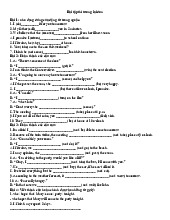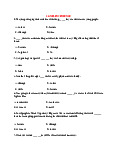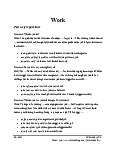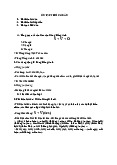


Preview text:
Name: MID-TERM TEST Class:
Subject: Phonetics and Phonology Time limit: 25 minutes
Please read the questions and circle the correct answer.
1. Which of the following statements is correct ?
a. Stops are consonants produced with a continuous airflow through the mouth.
b. Fricatives are consonants produced with the complete stoppage of the air in the mouth which causes an explosion.
c. Nasals are consonants produced with the lowering of the soft palate.
d. Approximants are non-continuant.
2. Which of the following is the stress distribution for the compound word <green house=? a. ['gri:n haus ] b. [ gri:n 'haus ]
c. ['gri:n 'haus ] d. [gri:n haus ]
3. Which of the following coarticulation processes may happen to the alveolar / n / in this context : [ ten men] ten men ? a. voicing assimilation b. progressive assimilation c. mutual assimilation d. labialization
4. Which of the following statements is incorrect ?
All the aspirated voiceless stops are produced with
a. no vibration of the vocal cords
b. an extra puff of the air strongly expelled
c. the air stream from the glottis
d. the air stream going through the oral cavity
5. Which of the following groups contains a segment that differs in place of articulation from the other segments? a./ t, r, d, s /
b. / k, g , ŋ, w/ c./ p, b, m, n / d. / t, d, n, z /
6. Which of the following groups contains a segment that differs in voicing from the other segments ?
a./ d, v, b, m / b./ m, n, ŋ, v /
c. / w, z , r, l / d./z, t , ∫, s /
7. Which of the following statements is correct ?
a. Velars are sounds made at the soft area toward the rear of the roof of the mouth.
b. Palatals are sounds made just behind the alveolar ridge
c. Bilabials are sounds made at the teeth ridge
d. Alveolars are sounds made with the tongue placed against the teeth
8. Which of the following symbols corresponds to the following phonetic
description : voiceless labiodental fricative
a.[ v ] b. [ w ] c. [ ð ] d. [ f ]
9. The process by which an alveolar stop is heard intervocally (voiced) between 2 vowels, the first of
which is generally stressed ( in words such as meeting, party...) is called a.assimilation c. epenthesis b.deletion d. flapping
10. Which of the following symbols corresponds to the following phonetic description : short mid- high front vowel
a.[ i ] b. [ e ] c. [ o ] d. [ æ ]
11. Which of the following symbols corresponds to the following phonetic description: voiceless interdental fricative
a.[ m ] b. [ v ] c. [ t ] d. [ ]
12. Which of the following groups contains a segment that differs in manner of articulation from the other segments ? a.[ w, r, j ] c. [ , ð , s ] b.[ p, b, m ] d. [ t, d, k ]
13.Which of the following statements is correct ?
Interdentals are sounds made
a.with the tongue between the teeth
b.with the tongue on or near the hard palate
c.just behind the alveolar ridge
d.with the upper lip and the lower teeth 1
14. Which of the following coarticulation processes may happen to the alveolar [ d ] in this context : [ wud ju:] Would you?
a. [ d ] becomes voiced before the palatal [ j ]
b. [ d ] is deleted before the palatal [ j ]
c. [ d ] is dentalised by the following [ j ]
d. [ d ] coalesces with [ j ] to make a new sound / dZ/
15. Which of the following statements is correct ?
Regressive assimilation is a process by which
a.the change of a segment is brought by the preceding segment
b.a sound copies one or more phonetic features from the following sound
c.a sound becomes less like the preceding sound
d. two sounds coalesce to make a new sound.
16. Which of the following is not considered (an) articulator(s)? a. the tongue b. the lips c. the velum d. the ears
17 Which of the following coarticulation processes may occur for the articulatory transition from the
[ m ] to the [ ] to be eased in this context [ súmIN ] ? a.the deletion of [ m ] b.the deletion of [ ]
c.the delition of the sound sequence [ m ]
d.the epenthesis of a [ p ] within the sequence [ m ]
18. Which of the following phonetic variations may happen to the voiced stop [d ] in this context : [ li:d ] lead ?
a.[ d ] is aspirated after the front vowel [i:]
b.[ d ] is devoiced after the long vowel [i:]
c.[ d ] is devoiced word finally
d.[ d ] is aspirated in the final position of a stressed syllable
19. Which of the following coarticulation processes may happen to the alveolar [ t ] in this context : that girl ?
a.[ t ] may be devoiced before the voiced stop [g ]
b.[ t ] may be aspirated before the voiced stop [ g ]
c.[ t ] may be labialised before the velar [ d ]
d.[ t ] may be velarised before the velar [ g ]
20. Which of the following words does not contain a front vowel? a. seen b. hat c. hit d. not
21. According to the ……………….., vowels can be rounded or unrounded.
a. height of the raised part of the tongue b. raised part of the tongue c. length of the vowels d. shape of the lip
22. ……………… are sounds articulated by the lower lip against the upper teeth. a. labio-dentals b. alveolars c. velars d. glottals
23. Which of the following phonetic transcriptions corresponds to the following
phonetic description: low back vowel ? a. / u / b. / æ / c. / i / d. / a: /
24. Which of the following phonetic transcriptions corresponds to the following
phonetic description : voiced alveolar stop ? a./ t / b. / t∫ / c. / d / d. / j /
25. Which of the following symbols corresponds to the following phonetic description: voiceless bilabial stop? a./ v / b. / g / c. / ð / d. / p / 2 A B C D A B C D 1 21 2 22 3 23 4 24 5 25 6 26 7 27 8 28 9 29 10 30 11 31 12 32 13 33 14 34 15 35 16 36 17 37 18 38 19 39 20 40 3




